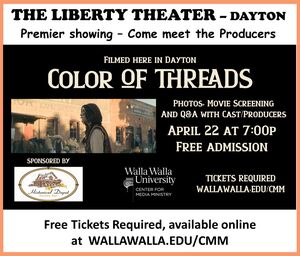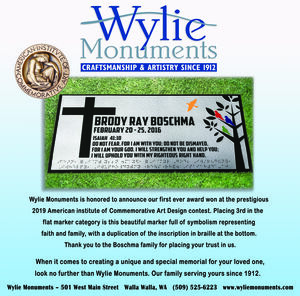WW II Memorial Project on Track for 2018
Waitsburg’s Norman Estes, Anthony Lloyd, Merle Eaton and Bobby Pettichord will be honored
November 9, 2017
As we approach Veterans Day, we reflect on many things. Those of us who are veterans, think about comrades we served with, missions carried out, places where we served, lessons learned, and how our lives were changed because of military service. Mostly we remember our comrades. We began as strangers from all over the country, standing in the same line at basic training waiting to be issued uniforms, boots, and gear. As training progressed, it wasn’t the uniform that blended us into a team. That developed over time and through experience. That bond has existed among soldiers since the beginning—the now over-used “band of brothers,” but that’s what it is. Veterans Day has been set aside to commemorate a specific event, but it is a symbol for all time.
That’s what the World War II Memorial Project to be built in Fort Walla Walla Park is all about—commemoration, remembrance, and most of all respect. At some time during the war, approximately 3,800 men and women from Walla Walla County (population 30,000 in 1940) answered the call to arms. By the time President Truman officially declared the war to be at an end on December 31, 1946, ninety men had made the ultimate sacrifice including six POWs. The multi-element monument will stand on a pentagon-shaped concrete pad just east of the Fort Walla Walla Museum. Three gray Vermont granite pillars, representing air, land, and sea warfare, are designed similar to those in Washington, D.C. The names and ranks of the casualties will be engraved on the pillars. A large stone will hold our dedication statement and bronze emblems of the four military services—Marines, Navy, Army, and Army Air Corps. In the center will be a flag pole donated by AmVets Post 1111.
The cities of Walla Walla, College Place, and Waitsburg have provided financial support. The general public has been generous with cash donations, but we still have a ways to go. Several businesses will also be furnishing some substantial in-kind donations. These will be named in an ad in the upcoming supplement in the November 19 issue of the Walla Walla Union-Bulletin.
An unplanned extension of the project has resulted in the research and writing of a brief narrative about each of the 90 casualties. Two committee members did this on their own, along with their regular fund raising and promotional duties. Those who were lost are much more than names on a roster. They were someone’s son, brother, uncle, husband or neighbor. Three of the men were from Waitsburg—CPT Norman Estes, 1LT Anthony Lloyd, and 2LT Merle Eaton. With the construction of this memorial, none of them will ever be forgotten.
This project is taking longer than any of us imagined, but we are all fully committed to complete the mission. We all owe the entire “greatest generation” for the freedoms we have today and so much more. When the soldiers, sailors, Marines, and airmen came home, they did not expect to have statues and monuments built for them. They considered themselves as ordinary men who fulfilled their duty and just wanted to get on with their lives. Ordinary maybe when they left home, but their service was anything but ordinary. Instead, the men who returned to Walla Walla asked for recreational venues as a “living memorial” that they could enjoy with their families and would benefit the entire community. This request was answered with Veterans Memorial Golf Course and Veterans Memorial Pool. Now 70 years later with the ranks of WWII veterans rapidly dwindling, a committee was formed to establish a permanent reminder. We are on track to dedicate the planned memorial on Veterans Day 2018.
Information about the project may be found at http://www.wwiimemproj.com. Donations may be sent to Fort Walla Walla Museum, 755 Myra Road, Walla Walla 99362 with WWII memorial on the memo line. Questions may also be directed to Neil & Sherilyn Jacobson, committee members, at 509-876-2425.
Narratives of the Waitsburg honorees follow.
----------------------------
Captain Norman Bradford Estes
October 29, 1916 – February 12, 1945
Norman was born in Lincoln County, WA to Thomas and Goldie Schoonever Estes. He had two older sisters and a younger one—Marion, Edith, and Bertha. Brother Elmer was two years older. The only other information about Norman’s early years includes graduation from high school and living in a boarding house in Walla Walla on Boyer Avenue. At some time he also lived in Waitsburg. On July 23, 1942 Norman married Frances Zuger in Walla Walla.
He enlisted in the Army on March 7, 1941 in Spokane as a Private. At that time his occupation was vehicle mechanic. No further information is currently available regarding how he was commissioned, unusual for someone with only a high school diploma so it may have been a battlefield commission. All that is known is that CPT Estes perished in Germany and is buried in Margratin, Holland in the Netherlands American Cemetery. His memory is commemorated on the Wall of Honor at the Waitsburg City Cemetery and there is a headstone marking an empty grave. Source: http://www.ancestry.com
-------------------------------
Second LT. Merle Stimmel Eaton
1921- April 5, 1946
Born in 1921, Merle joined parents Clarence and Charlotte May Eaton and sister Ursula. Another sister, Clara Jean, was added later. The family was in Waitsburg at least by 1930. The census also lists three men living with the family—George Prest (age 72), Robert Russell (age 59), and Laurence May (age 17), but no information about them. Laurence might have been a relative of Mrs. Eaton. By 1940, Ursula is no longer living at home, but there was a woman listed as Kranela who would have been the same age. At that time Merle had completed high school and was working as a tractor driver. In 1941 he enrolled in Washington State College as an engineering major. In 1942 he was living in Seattle.
On March 12, w1943 Merle enlisted in the Army Air Corps as an aviation cadet in Santa Ana, CA with one year of college to his credit. Another source states he entered the Army Reserve Medical Administrative Corps.
At some point Cadet Eaton was commissioned and assigned to the 882nd Bombardment Squadron, 500th Bombardment Group (Very Heavy) as a pilot for the B-29 Superfortress and credited with flying six sorties. The 882nd was activated in November 1943 and trained in Kansas. There were frequent delays in training as modifications to correct production deficiencies were made. Training completed, the squadron moved to Isely Field on Saipan in January 1945. The 882nd was assigned to the XXI Bomber Command of the 20th Air Force. Its mission was strategic bombing of Japanese home islands and destruction of its war-making capabilities. Wide-area firebombing attacks using incendiary and high explosive bombs were carried out resulting in major damage. This continued until the end of the war in August 1945. The mission shifted to carrying relief supplies to Allied POW camps in Japan and Mancuria until fall when it was demobilized and sent to March Field, CA. The entire 500th Bomb Group was deactivated in January 1946.
One source states that 2LT Eaton was the co-pilot of Z Square 31, nicknamed “Homing De-Vice” on a bombing missing to destroy the Tachikawa aircraft plant near Tokyo. All communication was lost after take-off and no wreckage was found. It is presumed the plane crashed into the ocean or Tokyo Bay. It is not even known if Z-31 reached its target. The date of the mission must be incorrect since combat missions were no longer being flown and the 500th had already been deactivated. Further research is required. 2LT Eaton’s name is engraved on the Tablets of Honor at the National American Cemetery of the Pacific in Honolulu, HI. He was posthumously awarded the Purple Heart and Air Medal with Oak Leaf Cluster. There is a grave marker for him in the family plot of the Waitsburg Odd Fellows Cemetery. It is probable that Merle married. A 500th Bomb Group report lists Marilyn Eaton of Merced, CA as his next of kin. Sources: https://en.wikipedia.org, http://www.ancestry.com, http://www.fold3.com, http://www.wwiimemorial.com
------------------------------
First LT. Anthony Boynton Lloyd
March 12, 1915 – January 7, 1943
The Lloyd family has been in the Waitsburg area for many years going back to the early pioneer days. Tony’s grandfather, Albert Gallatin Lloyd, was a volunteer militiaman who fought in the Battle of Walla Walla in December 1855. Conversely Tony’s father, Wesley A. Lloyd, became known as “a friend of the Indians”. During his lifetime, pack trains to the Idaho gold field gave way to railroads and trackless prairie gave way to wheat ranches. Mr. Lloyd came to know the local Indians quite well, even learning their languages which was helpful since his land was next to theirs. Tony and his younger brother, Milton, grew up in this rich environment receiving many handmade native items and learning much about Indian lore from their neighbors. In recent years, the Lloyd family has generously donated a large number of artifacts to Fort Walla Walla Museum that are now on permanent display.
Among other figures of notoriety in the area, Mr. Lloyd once sold a horse to CPT Wainwright whose father was in the Cavalry at Fort Walla Walla. At some time during Tony’s all too brief military career, he served under General Wainwright in the Pacific.
Tony graduated from University of Washington with a degree in chemical engineering. A different a skill he developed while a student, was marksmanship with rifles and resolvers. He won many competitions with the ROTC team including national meets.
Tony’s brother, Milton, served his country for four years earning the rank of First Sergeant while assigned to the 646th Technical School Squadron.
One source indicates that Tony enlisted in the Army Reserve as an officer in 1940 while another states he was called up for duty with other Reserve officers. At any rate, LT Lloyd was sent to March Field, CA and was deployed overseas in September 1941 to Fort Mills, Corregidor in the Philippines. He was assigned to the 78th Coast Artillery. Later he served with Battery H, 60th Coast Artillery Regiment that was tasked with anti-aircraft defense of Manila and Subic Bays. (See separate information about the Coast Artillery Corps.) His last letter home was written on November 17, 1941. Corregidor fell in May 1942 and all allied troops, including 1LT Lloyd, were taken prisoner. Locations included Bilibid, a POW hospital; Cabanatuan; and finally Kokura, Japan on Shokuku Island. A year later, the family received a message from a SGT Russell that Tony was still alive in a Philippine POW camp. This was cruel false hope since 1LT Lloyd had already perished of malnutrition at the hands of his captors on January 7, 1943. Repeated attempts by International Red Cross had yielded nothing.
In July 1943, his parents saw a news reel in a movie theater. It showed American soldiers being taken prisoner by the Japanese on Corregidor. Mrs. Lloyd was certain one of them was her son. The theater manager gave them a section of the film so they could have a still picture made. Even though positive identification could not be made, the Lloyds held out hope that Tony was still alive somewhere. Official notice was not received until December 1945.
On March 8, 1946, 1LT Lloyd’s parents received a letter announcing the posthumous award of the Silver Star “for gallantry in action on Corregidor, Philippine Islands on 28 April 1942. During a heavy Japanese artillery concentration of a battery position, the electrical power transmission cables were destroyed by artillery. Completely disregarding his own safety, Lieutenant Lloyd left cover, exposed himself to enemy fire for two hours, and repaired these vital cables thereby bringing the battery back into synchronization. By his sustained gallantry and courageous devotion to duty, Lieutenant Lloyd rendered invaluable aid to our forces during a critical period of operation”.
As a lasting tribute to 1LT Anthony Lloyd, a U.S. flag was eventually presented to Mrs. Lloyd. In turn his brother, Milton, presented it to the Waitsburg American Legion post in 1957. The Legionnaires proudly fly the flag over the city cemetery each Memorial Day and Veterans Day in his honor.
Sources: http://www.ancestry.com, Fort Walla Walla Museum library files
-----------------------------------
PVT. First Class Bobby Norman Pettichord
March 2, 1925 – June 13, 1945
Bobby’s parents were Earl and Blanche with siblings Richard and Billie completing the family. His formal education included three years of high school.
Bobby enlisted in the Army in Spokane on July 23, 1943. At the time of his death on Luzon in the Philippines two years later, he was assigned to Company G of the 20th Infantry Regiment. The only information about his military service is a Navy muster roll dated May 27, 1944. The USS General John Pope (AP-110) was a troop transport from San Francisco bound for Edur at the northern tip of India. One source states she was headed for ports in New Guinea, Guadalcanal, and the Russell Islands (part of the Solomons).
The 20th Infantry Regiment was assigned to the 6th Division in October 1939 and became known as Sykes Regulars. Its elements participated in the campaigns on New Guinea and Luzon that included bitter fighting through jungles and up mountains. They debarked at Maffin Bay on New Guinea in mid-June 1944 and fought Japanese soldiers to total destruction by December. The new year found the 20th on Luzon Island with General MacArthur liberating the same people the American Army had policed 40 years earlier. On January 9, the 20th landed on Blue Beach in Lingayen Gulf and took on 250,000 well-equipped Japanese who had spent three years fortifying the area. The Sykes Regulars took the beaches and Purple Heart Valley across the 6,000 bloodiest yards in the world at the time. It was during this campaign that PFC Pettichord was killed and posthumously awarded the Bronze Star. He is buried in the Waitsburg City Cemetery near other family members and his name is engraved on the Wall of Honor. A government-issue headstone was requested in 1951 by his mother, remarried to a Mr. Watt, and it is in the veterans section of Walla Walla’s Mountain View Cemetery.
Following consolidation, the 20th Infantry Regiment moved to Munoz Island. With other elements of the 6th Infantry Division, the 20th was the most heavily engaged Army unit having spent 219 consecutive days in combat. They faced the last groups of organized resistance in the Pacific Theater until the cease fire was ordered on August 15, 1945.
Sources: https://wn.wikipedia.org, http://www.ancestry.com, http://www.fold3.com, http://www.history.army.mil, http://www.1-20infantry.org














Reader Comments(0)